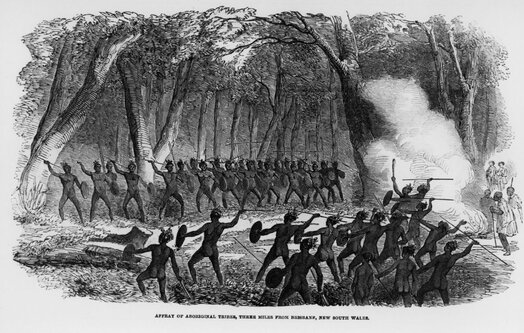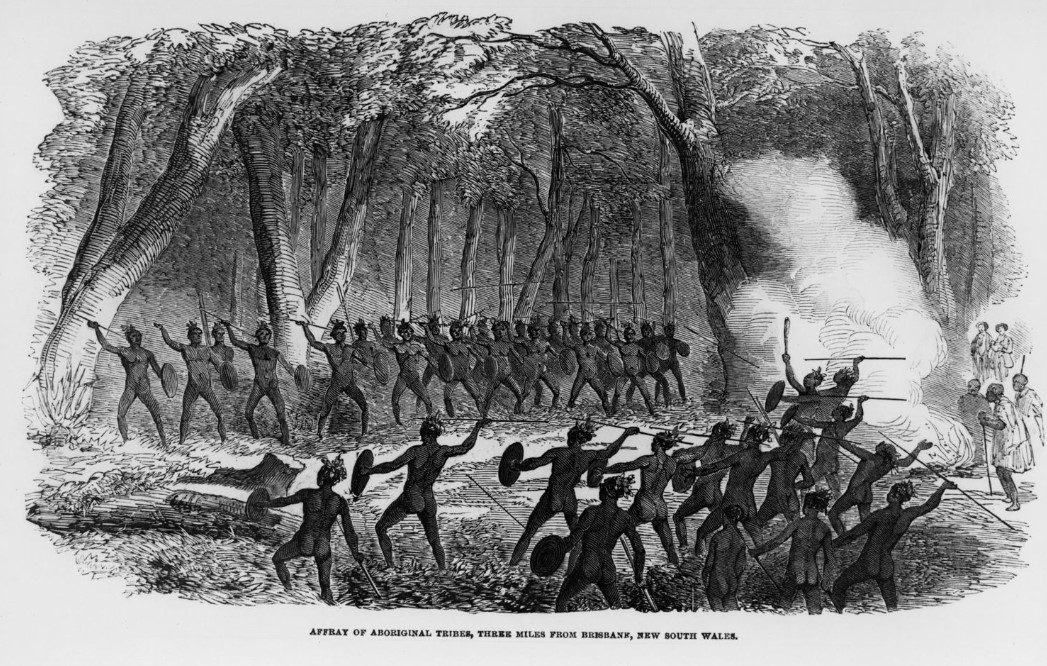Old Moppy (1790s – 1841) was a powerful leader and talented warrior of the Lockyer region, active from ca. 1837 to 1841. He is best known for organising early resistance on the Upper Brisbane and near Grantham, and for forging an alliance of ‘Mountain tribes’ (groups from the Darling Downs, Scenic Rim, Stanthorpe, D’Aguilar range and Upper Brisbane) that continued to operate under his son, Multuggerah, in fighting incursions of settlement.
‘Old Moppy’ was also known as Moppé, ‘Moppy the chief’ and Chief Moppy. Some sources confuse or blend Old Moppy with his son, who was also called Moppy but better known as Multuggerah. The nickname applied to the ‘moppy’ hair of both individuals.
Old Moppy was born in the late 1790s. He probably emerged as a leader in the early 1830s. In 1837, he led an inter-tribal fight against coastal groups at Taringa. With his allies from the Scenic Rim, he mustered over 700 warriors for the battle. At that time, he was around 40 years old, over seven foot tall and heavily muscled.
In winter of 1840, Old Moppy visited Lieut. Owen Gorman in Brisbane and was given a breastplate naming him ‘King of Upper Brisbane’. He later had this returned. Soon after, Gorman visited Old Moppy at his main camp near Gatton during an exploratory expedition. The assistance of Old Moppy and his sons enabled Gorman to conduct the earliest exploration of the region between Ipswich and Toowoomba, and locate a suitable pass over the Great Divide to the Darling Downs (namely Gorman’s Gap).
Earlier, Gorman had promised to help find and punish the whites who had shot at Old Moppy’s people. When Gorman failed to honour his promise by punishing the offenders, Old Moppy led some 300 to 500 warriors in attacking the runs of Upper Brisbane, effectively retaking the settled land and displacing the settlers.
Soon after, on account of the destruction of the main camp at Grantham in his people’s absence (all hut sheets were stolen, dogs killed, etc), Old Moppy began holding runs in Tent Hill and Grantham under siege. He also organised stone pens in which his warriors tried to muster sheep. All flocks of sheep had to be temporarily removed from the valley due to Moppy’s raids.
In retribution, some 14 Europeans under James ‘Cocky’ Rogers – the supervisor – undertook a dawn raid on the Grantham camp. In this affray, two Europeans were severely wounded and Wooinambi – who is thought to have been Old Moppy’s son – was killed.
The incident resulted in Gorman leading an inquiry, including an expedition during which ‘Cocky’ Rogers was temporarily arrested. The arrest infuriated Rogers, who later threatened Gorman for his action. Rogers also then conducted a surprise attack on Old Moppy at Blackfellows Creek (Tent Hill) whilst Old Moppy was fishing. This seems to have been late in 1841. According to George Thorn (the first Ipswich settler), ‘Blackfellows Creek’ was in fact named by locals after the death of Old Moppy at this location. The action was widely decried in later reports as a cowardly act. Lands Commissioner Dr Simpson noted that “Moppy’s sons” were incited to step up their attacks on account of his death.
Citation
Ray Kerkhove and Amanda Spinks, ‘Old Moppy (1790s – 1841)’, Harry Gentle Resource Centre, Griffith University, 2018 (last updated 2023), https://harrygentle.griffith.edu.au/life-stories/oldmoppy/.
Archival Resources
State Library of Queensland, Colonial Secretary's Correspondence, A2 Reels [microfilm]
Lieut. Owen Gorman to Colonial Secretary, Letter, 1 Nov 1840, CS Ref. No. 40/12644, Reel A2.11, pp. 319-322.
State Library of Queensland, Colonial Secretary's Correspondence, A2 Reels [microfilm]
James Rogers, Deposition, ca. 23 Oct 1841, CS Ref. No. 41/9744, Reel A2.12, pp. 117-119.
Books
Raphael Cilento and Clem Lack, Triumph in the Tropics: An Historical Sketch of Queensland.
Brisbane: Smith & Paterson, 1959.
Raymond Evans, A History of Queensland.
Cambridge, New York: Cambridge University, 2007.
Alan Queale, The Lockyer - Its First Half Century.
Gatton, Qld: Gatton & District Historical Society, 1977.
Don Talbot [revised Don Neumann], A History of Gatton & District, 1824-2008.
Gatton, Qld: Lockyer Valley Regional Council, 2014.
A. M. Tew, History of the Gatton Shire in the Lockyer Valley.
Gatton, Qld: Gatton Shire Council, 1979.
F. Uhr, The Day the Dreaming Stopped: A Social History investigating the sudden impact of the pastoral migration in the Lockyer and Brisbane Valleys 1839 to 1846.
A coursework thesis by Frank Uhr in partial fulfilment of the degree of Master of Arts, University of Queensland, 2009.
Ray Kerkhove, Multuggerah and Multuggerah Way.
Enoggera, Qld: Ray Kerkhove, 2016.
Ray Kerkhove, Historical Context of Toowoomba Bypass from Main Range Escarpment to Helidon.
Report for Department of Transport and Main Roads and Jagera Daran.
Journals
Gorman’s Gap. J. Keith Jarrott, Queensland Heritage , Vol. 3, No. 4, 1976, pp. 24-38.
The Raid of the Aborigines: A brief overview and background to the poem. F. Uhr, Journal of the Royal Historical Society of Queensland , Vol. 17, No. 12, 2001, pp. 559-561.
September 12 1843: The Battle of One Tree Hill – A Turning Point in the Conquest of Moreton Bay. F. Uhr, Journal of the Royal Historical Society of Queensland, Vol. 18, No. 6, 2003 pp. 241-255.
Newspapers
Romance of Real Life in Australia, Colonial Times, 24 May 1850, p. 4.
Ipswich, Moreton Bay Courier , 26 Jan 1860, p. 2 .
Raid of the Aborigines, Bells Life in Sydney and Sporting Reviewer , 4 Jan 1845, p. 4.
Lower Herbert, The Queenslander , 4 July 1874, p. 10 .
In the Early Days, The Queenslander , 27 February 1892, p. 402 .
Random Rhymes, The Moreton Bay Courier, 24 February 1855, p. 4.
Online Resources
Ray Kerkhove, 'Old Moppy (c. 1787-c.1842)', Australian Dictionary of Biography





